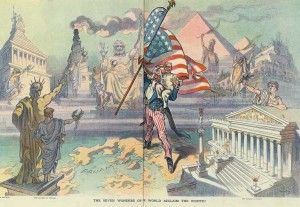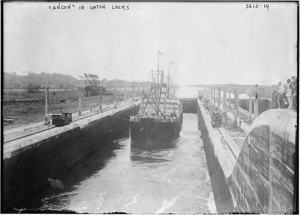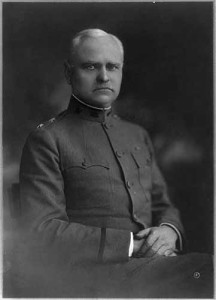A man, a plan, a canal – and flags! | The Panama Canal

One of the lowest points of the 20th century began 100 years ago when World War I broke out with the flags of many nations leading murderous charges. But one of the greatest achievements of the century also happened in 1914: The Panama Canal was completed as the American flag, among others, waved over the engineering marvel.
“The first thing in the morning” on August 15, 1914, reported The New York Times, “signal flags” were strung from one end to the other of the Ancon, the first ship to officially cross the canal. In addition, “the flags of all nations [were] hoisted on the ship to mark the international aspect of the occasion.”

A reporter wrote that the Ancon was “gay with bunting. Even the deck hands [were] rigged out in spotless new white uniforms,” and the ship itself was sporting a fresh coat of paint. Aloft, as “the ensigns of all nations” flapped in the wind, the flag of Panama was prominently displayed, while an American flag fluttered from the jack staff.
At 7 a.m., the ship slipped from its berth to begin its passage through the locks of the canal, a journey that would last about 12 hours. On board was General George Washington Goethals, the man behind the plan that created the canal.

Two years earlier, Goethals had delivered the graduation address at West Point, his alma mater. His closing words to the cadets must have encapsulated the philosophy behind the building one of the wonders of the world: “Face every task with determination to conquer its difficulties and never let them conquer you.”
His epic task was now complete. As a countersign to the brutal war being waged in Europe, Goethals ordered that the flag of the American Peace Society be flown on the foremast of the ship. But there was an ironic counterweight hidden below decks.
The Peace Society’s aim was to “promote permanent international peace through justice; and to advance in every proper way the general use of conciliation, arbitration, judicial methods, and other peaceful means of avoiding and adjusting differences among nations, to the end that right shall rule might in a law-governed world.”
While the peace banner waved above the Ancon, the Times noted that “beneath her decks were two huge pieces of artillery which are destined to form an important part of the defense of the waterway.”

I am interested in acquiring an original american flag from the Panama Canal. Particularly interested in a flag with historical significance. Can you assist me in learning about the existence and availability of such flags? Thank you